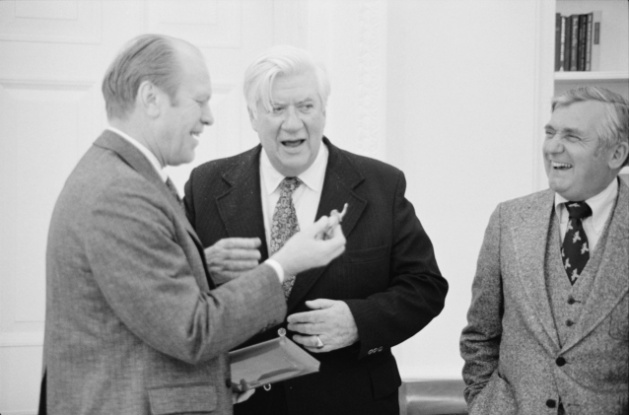Previously published at WGBHNews.org.
There was a time not too many years ago when Digital First Media — the all-but-certain next owner of the Boston Herald — was the toast of the newspaper business. The chain was led by a brash, profane chief executive named John Paton, who espoused an aggressive post-print strategy built around free, advertiser-supported websites, community engagement, and high-profile initiatives such as Project Thunderdome, a national news and innovation center.
It all fell apart quickly. Alden Capital, the hedge fund that controls Digital First, grew impatient with Paton’s grandiosity. Project Thunderdome was dismantled in 2014. Paton left in 2015. And the chain embarked on a relentless strategy of cutting costs to the bone. “If you work for a company owned by a hedge fund, it’s like walking through a minefield,” Jim Brady, Digital First’s former editor-in-chief, told me in 2016. “Any step can be the one where you hit the mine. Any day it could end, and you know that.”
Brady has since turned entrepreneur, founding mobile-friendly local news sites in Philadelphia (Billy Penn) and Pittsburgh (The Incline). And the post-Paton Digital First has earned a reputation for brutal cost-cutting — which raises serious concerns about what its executives have in mind for the Herald.
Digital First, based in Denver, won the Herald sweepstakes on Tuesday by outbidding two rivals. When the Herald’s soon-to-be-former owner, Pat Purcell, took the Herald into bankruptcy in December, he said the paper would be acquired by GateHouse Media, another chain controlled by a hedge fund. But Digital First, a late entry, bid a reported $11.9 million, outdistancing GateHouse’s $4.5 million and a lesser-known contender, Revolution Capital Group.
In the short term, there might not be that much difference between GateHouse and Digital First. GateHouse would have cut the number of people employed by the Herald from 240 — about half of them editorial staff members — to 175. Digital First reportedly reached an agreement with the Newspaper Guild recently to offer jobs to about 175 people. Long-term, though, there is reason to believe the Herald might have been better off under GateHouse, despite the company’s own well-deserved reputation for obsessing over the bottom line.
Why? Consider the gap between the two bids. GateHouse’s much lower offer suggests that it would not have had to cut as much to earn back its investment. GateHouse also has a substantial infrastructure in Greater Boston, with more than 100 community newspapers, including dailies such as The Patriot Ledger of Quincy, the Telegram & Gazette of Worcester, and the Providence Journal. The Herald is currently printed by The Boston Globe, but GateHouse has considerable press capacity of its own. Finally, GateHouse officials appeared to have a plan, and had been talking with people both inside and outside the Herald for weeks. (Disclosure: including me.)
By contrast, Digital First’s intentions are a mystery. But recent news about the company has not been good. The company recently eliminated the editor’s job at the Sentinel & Enterprise of Fitchburg, one of its two dailies in Massachusetts, and is now running the paper out of its other daily, The Sun of Lowell. Even more ominous, the Sentinel is getting rid of its newsroom, with journalists being told to work out of their homes. As a friend put it upon hearing the news that Digital First will soon own the Herald: “How long before the newsroom is relocated to a nearby Starbucks with free WiFi?”
In California, Digital First has gone on a rampage that rivals Sherman’s march through Georgia. According to the Los Angeles Times, the company’s Southern California News Group will soon eliminate at least 65 of the 315 newsroom positions at its 11 papers, which include such well-known titles as the Orange County Register and The Press-Enterprise of Riverside. That comes on the heels of 65 cuts last summer. Farther north, the once-great Mercury News of San Jose, which at its peak employed about 440 journalists, is down to just 39 union positions in the newsroom, with some non-union staff as well.
The newspaper business has been in trouble for more than two decades as technological and cultural changes have hollowed out its financial underpinnings. But greed should not be overlooked as a major contributing factor. Last fall I wrote about an investigation by The Nation into the hedge funds that own newspapers. Among other things, we learned from reporter Julie Reynolds that Randall Smith, the tycoon who controls Digital First, had purchased 16 mansions in Palm Beach, Florida, for $57 million, which he had amassed by “purchasing and then destroying newspapers.”
The one good-news story about Digital First involves the Berkshire Eagle — and that’s only because the chain sold the paper to local business leaders a couple of years ago. According to Shan Wang of the Nieman Journalism Lab, the Eagle and its affiliated newspapers in Vermont have been rebuilding their staff and their reputation since Digital First got out of town. Wang wrote:
Newly rid of Digital First Media and its cost-cutting ways, and now owned by people with real ties to the county, the Eagle newsroom was reinvigorated. The new owners laid out a guiding strategy — if you build it up, they will come back — and promised to stay in the business of local news for the long haul. Producing better, local-focused news, and more of it, they surmised, would be the straightest path to bringing back subscribers, raising more revenue — more to invest in digital products and, finally, sustainability.
What a concept. Of course, it’s a lot easier to go the independent route with small papers that enjoy local monopolies than with a large, money-losing number-two daily like the Herald, which has long labored in the shadow of the dominant Globe. If Purcell could have stayed in business, he would have.
Still, the optimist in me hopes that once Digital First has wrung whatever profits it can out of the Herald and is ready to move on, local investors will step forward who are willing to take a chance and return the paper to independent ownership. Unfortunately, the next few years are likely to be rocky — not just for Herald employees, but for their readers as well.





